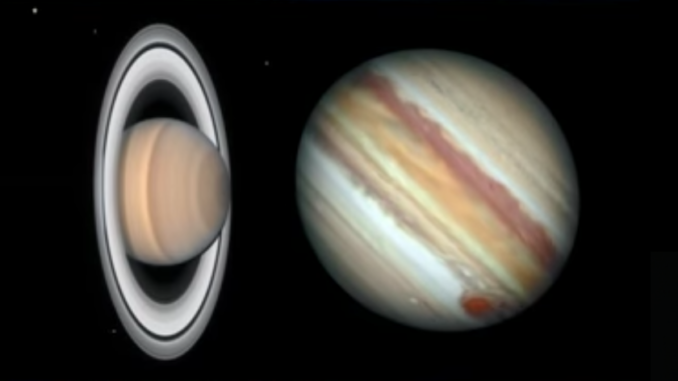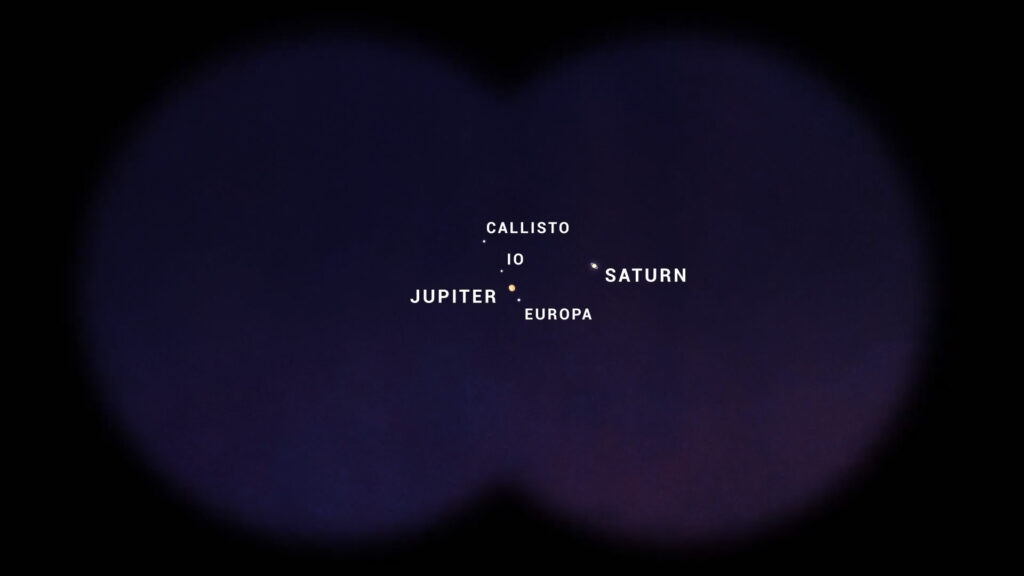
No doubt you’re already aware that Jupiter and Saturn are scheduled to appear very close together in the December 21st evening sky, coinciding with winter solstice. At first, I’d decided to not write about it because there are so many reports covering the event all over the media. I changed my mind when I realized that many of the news articles I’d read contained misleading or flat-out wrong statements, none of which were intentional of course, just in error. Also, for those that really want to see it, a little ‘heads up’ and preparation might be helpful.
First, let’s be clear what ‘very close together’ means: as seen from Earth, Jupiter and Saturn are lined up so that Saturn is nearly directly behind Jupiter. Saturn is still millions of miles farther away from Earth than Jupiter is, but because they’re both within our line of sight (only approximately one-tenth of a degree separating the two on December 21) they are perceived by the observer on Earth as being apparently very close together. Jupiter and Saturn will seem to be a single bright planet to the unaided eyes of anyone on Earth.

Astronomers call it a “great conjunction” because it’s a rare event. You may have read or heard that it hasn’t occured since the year 1226, which is incorrect. It’s a rare event, but not quite that rare. What several news outlets which reported that gem probably meant was that 1226 was the last time that Jupiter and Saturn were this close in proximity to Earth during a great conjunction and also appeared to be very close together. But even so, there’s more to that statement than meets the eye: they were also very close together in 1623, but very difficult to see from Earth because of interfering sunlight.
So how rare is it? A great conjunction occurs about once every 20 years: on average once every 19.6 years. What makes this one special (as well as the ones in 1226 and 1623) is how closely the gas giants line up in nearly a straight line with Earth, there being only a tenth of a degree separation between Jupiter and Saturn. This century will host another super-rare great conjunction in 2080 which will rival 2020. Great conjunctions in the years 2040, 2060, and 2100 will not be as impressive.

Saturn has been slowly catching up to Jupiter for months. At this time (December 10-11) they are slightly more than one degree apart from one another. As each day passes leading up to December 21, the pair will appear lower in the southwest sky, shortly after sunset. As twilight fades, Jupiter will be the first ‘star’ you’ll see in the southwest. With a pair of binoculars, you’ll easily be able to see Saturn close by Jupiter within the field of view, slightly east and a little higher in the sky. The farther north you are, the lower Jupiter will be in the sky, and the less time you’ll have to observe the conjunction before the pair set below the horizon. This, and the fact that you’ll want to be sure you’ve found an unobstructed view of the southwest sky, is why you should go out to look for Jupiter and Saturn well before December 21. Then, even if clouds prevent your observation on winter solstice, you can still say you saw the lead up to the great conjunction in 2020.
To be sure myself, I went looking for the pair a few hours ago. I started about 5:45pm, but it was almost 6pm before dusk had faded enough for Saturn to stand out. I was also concerned about tall trees blocking my view (they may turn out to be a problem for me in another ten days as the conjunction sinks lower every day, edging closer to the horizon)..
The most memorable sights I’ve seen with my telescope were: (1) the sheer size of Jupiter with his Galilean moons Callisto, Europa, Ganymede, and Io; (2) the breathtaking majestic rings of Saturn. I intend to get the scope out of storage to observe the great conjunction. It will be worth the hassle to see the two impressive giants together.
If you don’t have a telescope, I’d encourage you to contact a local amateur astronomy group. They often have star parties that they invite the general public to attend. Don’t be shy! They invite company because they want to share their enthusiasm for astronomy with you.
As a last resort if you have a pair of binoculars, that would be better than nothing. Brace them against something solid, such as the roof of your car, to minimize image ‘jiggling’.
What’s Up: December 2020 Skywatching Tips from NASA (3:24):
Question of the Night: What do you like about winter?
